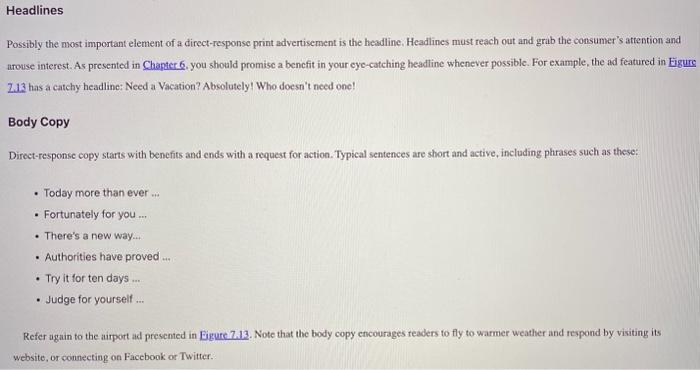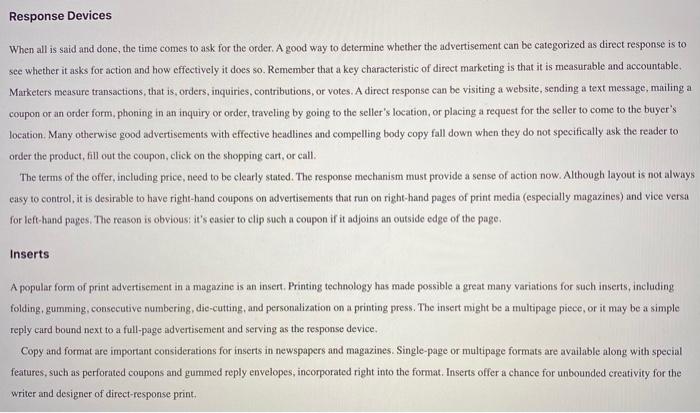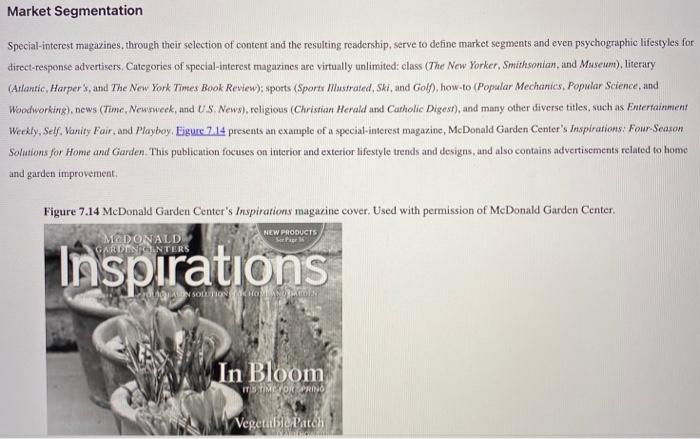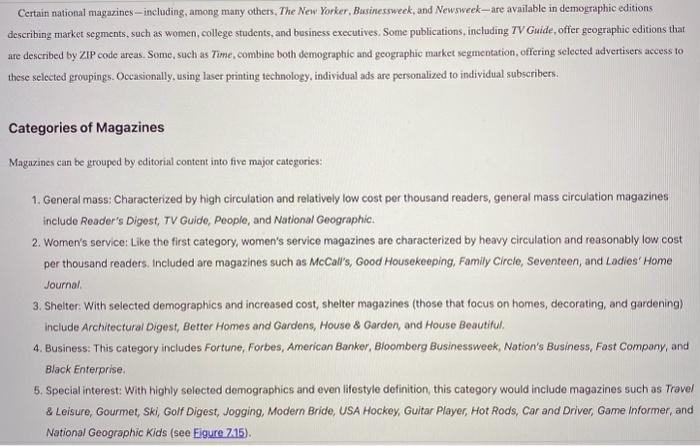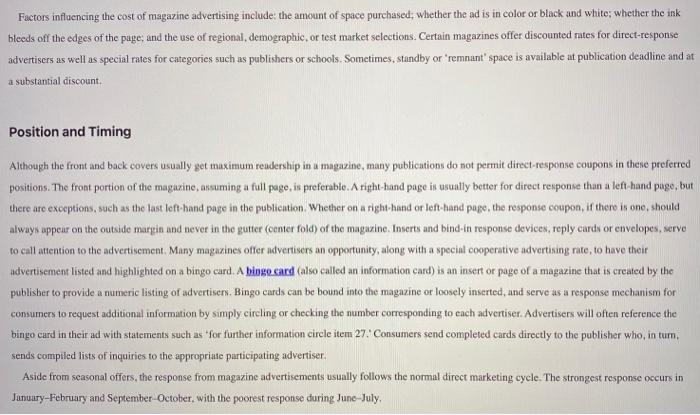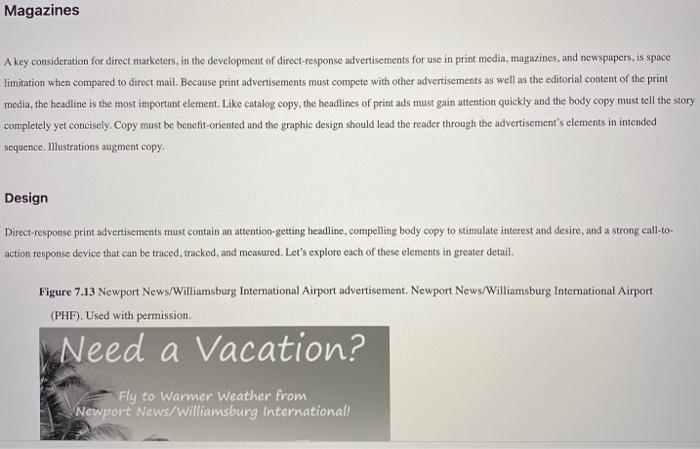
Find a magazine advertisement (must be in a PHYSICAL PAPER MAGAZINE, not online) that utilizes a multi-channel call to action, i.e. any combination of a phone number, QR code, web site and/or landing page.
Describe the ad or -- better yet - - provide a scan or photo of it. Follow and comply with each of the calls-to-action offered in the ad. You don't have to buy anything - just call/go online/etc. and describe what happens.
Describe the synergy, or lack thereof, between the various channels. Example: when you go to the web site or landing page, does it relate to the ad? How so or how not?
A key consideration for direct marketers, in the development of direct-response advertisements for use in print media, magazines, and newspapers, is space limitation when compared to direct mail. Because print advertisements must compete with other advertisements as well as the editorial content of the print modia, the headline is the most importast element. Like catalog copy, the headlines of print ads must gain attention quickly and the body copy must tell the story eompletely yet concisely. Copy must be benefit-oriented and the graphic design should lead the reader through the advertisement's elements in intended sequence, Illustrations augment copy, Design Direct-response print advertisements must contain an attention-getting headline, compelling body copy to stimulate interest and desire, and a strong call-toaction response device that can be traced, tracked, and measured. Let's explore each of these elements in greater detail. Figure 7.13 Newport News/Williamsburg International Airport advertisement. Newport News/Williamsburg International Airport (PHF), Used with permission. Possibly the most important element of a direct-response print advertisement is the headline. Headlines must reach out and grab the consumer's attention and arowse interest. As presented in Chapter 6, you should promisc a bencfit in your cye-catching headline whenever possible. For example, the ad featured in Eigy 2.13 has a catchy headline: Need a Vacation? Absolutely! Who doesn't need one! Body Copy Direct-response copy starts with benefits and ends with a request for action. Typical sentences are short and active, including phrases such as these: - Today more than ever - Fortunately for you... - There's a new way... - Authorities have proved .. - Try it for ten days ... - Judge for yourself ... Refer ugain to the airport ad presented in Eigure 7.13. Note that the body copy encourages readers to fly to warmer weather and respond by visiting its website, or connecting on Facebook or Twitter. When all is said and done, the time comes to ask for the order. A good way to determine whether the advertisement can be categorized as direct response is to see whether it asks for action and how effectively it does so. Remember that a key characteristic of direct marketing is that it is measurable and accountable, Marketers measure transactions, that is, orders, inquiries, contributions, or votes. A direct response can be visiting a website, sending a text message, mailing a coupon or an order form, phoning in an inquiry or order, traveling by going to the seller's location, or placing a request for the seller to come to the buyer's location. Many otherwise good advertisements with effective headlines and compelling body copy fall down when they do not specifically ask the reader to order the product, fill out the coupon, click on the shopping cart, or call. The terms of the offer, including price, need to be clearly stated. The response mechanism must provide a sense of action now. Although layout is not always easy to control, it is desirable to have right-hand coupons on advertisements that run on right-hand pages of print media (especially magazines) and vice versa for left-hand pages. The reason is obvious: it's easicr to clip such a coupon if it adjoins an outside edge of the page. Inserts A popular form of print advertisement in a magazine is an insert. Printing technology has made possible a great many variations for such inserts, including folding, gumming, consecutive numbering, die-cutting, and personalization on a printing press. The insert might be a multipage piece, or it may be a simple reply card bound next to a full-page advertisement and serving as the response device. Copy and format are important considerations for inserts in newspapers and magazines. Single-page or multipage formats are available along with special features, such as perforated coupons and gummed reply envelopes, incorporated right into the format. Inserts offer a chance for unbounded creativity for the writer and designer of direct-response print, Special-interest magazines, through their selection of content and the resulting readership, serve to define market segments and even psychographic lifestyles for direct-response advertisers, Categories of special-interest magazines are virtually unlimited: class (The New Yorker, Smithsonian, ind Museam), literary (Atlantic, Harper's, and The New York Times Book Review); sports (Sportr Mastrated, Ski, and Golf), how-to (Popular Mechanics, Popular Science, and Woodworking), Dews (Time, Newsweek, and US. News), religious (Christian Herald and Catholic Digest), and many other diverse titles, such as Eintertainment Weckly, Self, Vanify Fair, and Playbay, Eigure 7.14 presents an example of a special-interest magazine, McDonald Garden Center's Inspirarions: Four-Season Solutions for Home and Garden. This publication focuses on interior and exterior lifestyle trends and designs, and also contains advertisements related to home and garden improvement, Certain national magazines - including, among many others, The New Yorker, Businessweek, and Newsweek-are available in demographic editions describing market segments, such as women, college students, and business executives, Some publications, including TV Guide, offer geographic editions that are described by ZIP code areas. Some, such as Time, combine both demographic and geographic market segmentation, offering selected advertisers access to these selected groupings. Occasionally, using laser printing technology, individual ads are personalized to individual subscribers. Categories of Magazines Magazines can be grouped by editorial content into five major categories: 1. General mass: Characterized by high circulation and relatively low cost per thousand readers, general mass circulation magazines include Reader's Digest, TV Guide, People, and National Geographic. 2. Women's service: Like the first category, women's service magazines are characterized by heavy circulation and reasonably low cost per thousand readers. Included are magazines such as McCall's, Good Housekeeping, Family Circle, Seventeen, and Ladies' Home Journal, 3. Shelter: With selected demographics and increased cost, shelter magazines (those that focus on homes, decorating, and gardening) include Architectural Digest, Better Homes and Gardens, House \& Garden, and House Beautiful. 4. Business: This category includes Fortune, Forbes, American Banker, Bloomberg Businessweek, Nation's Business, Fast Company, and Black Enterprise. 5. Special interest: With highly selected demographics and even lifestyle definition, this category would include magazines such as Travel \& Leisure, Gourmet, Ski, Golf Digest, Jogging, Modem Bride, USA Hockey, Guitar Player, Hot Rods, Car and Driver, Game informer, and National Geographic Kid's (see Eigure 715). Advantages and Disadvantages Magarines can be selected to reach defined market segments; mass or class; rural, urban, or suburban; females or males; senior citizens or teenagers. Modern printitg technology permits cxecllent reproduction at a relatively low cost per thousand circulation. Because magazines usually come out periodically - weekly, monthly, quarterly - they enjoy relatively long life and often many readers will read a single copy. Through split-run techniques, in which alternative advertisements are placed in cvery other copy, magazines can be tested relatively inexpensively for ways to maximize direct response. On the negative side, however, magaxines offer direct marketers less space in which to tell their story than direct mail does. Additionally, elosing dates for magarines (the date by which the magazine must receive the ad) are often considerably in advance of the issue dates and, because of staggered distribution, over a long period of time, response is usually spread out over time and thus slower. Figure 7.15 National Geographic Kids magazine. Used with permission of The National Gcographic Society. Factors influencing the cost of magarine advertising include: the amount of space purchased; whether the ad is in color or black and white; whether the ink bleeds off the edges of the page; and the use of regional, demographic, or test market selections. Certain magazines offer discounted rates for direct-response advertisers as well as special rates for categories such as pablishers or schools. Sometimes, standby or "remnant' space is available at publication deadline and at a substantial discount, Position and Timing Although the front and back covers usually get maximum readership in a magazine, many publications do not permit direct-response coupons in these preferred positions. The front portion of the magazine, assuming a full page, is preferable. A right-hand page is usuatly better for direct response than a left-hand page, but there are exceptions, such as the last left-hand page in the publication. Whether on a right-hand or left-hand page, the response coupon, if there is one, should always appeuz on the outside margis and never in the gutter (center fold) of the magazine. Inserts and bind-in response devices, reply cards or envelopes, serve to call attention to the advertisement. Many magaxines offer advertisers an opportunity, along with a special cooperative advertising rate, to have their advertisement listed and highlighted on a bingo card. A bingo cand (also called an information card) is an insert or page of a magazine that is created by the publisher to provide a numeric listing of advertisers. Bingo cards can be bound into the magazine or loosely inserted, and serve as a response mechanism for consumers to request additional information by simply circling or checking the number corresponding to each advertiser. Advertisers will often reference the bingo card in their ad with statements such as 'for further information circle item 27 : Consumers send completed cards directly to the publisher who, in turm. sends compiled lists of inquiries to the appropriate participating advertiser. Aside from seasonal offers, the response from magazine advertisements usually follows the normal direct marketing cycle. The strongest response occurs in Junuary-February and September-October, with the poorest response during June-July

